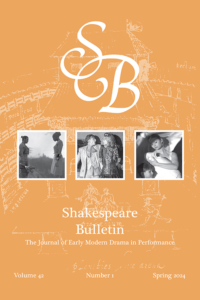Shakespeare Bulletin, 42.1
Opening Section
José Zayas’s production of Romeo and Juliet for the American Shakespeare Center’s (ASC) Spring 2022 season—the first season under Brandon Carter as artistic director—began very unusually. There were no servants saying “Do you bite your thumb at us, sir?”. No “dog of the  house of Montague move[d]” Tybalt, and, in fact, the Prince of Cats did not start a brawl in a Verona piazza. The actors finished speaking the prologue, and then the Capulets and Montagues immediately began fighting—a surprisingly violent and almost anti-linguistic beginning to this romantic play, its tension released rather than built up. This was not at all what I had come to expect from the ASC’s productions of early modern work, which tend toward preciousness, especially concerning Shakespeare’s language. The ASC brand has been set for decades, only occasionally offering variations on what the company calls “Shakespeare’s Staging Practices.” Productions behave according to set patterns: the actors double and triple the roles they play, often to hilarious comic effect; the shows are produced—as their slogan has it—with the lights on, in their Staunton, Virginia reimagining of the Blackfriars Theatre; costumes are vaguely period, as though the show is taking place in a space without time, or rather as though the show is taking place in a theater in the present; and there’s a fairly strict policy against cutting characters. An ASC show almost never displays a strong directorial hand; the words and the actors are understood to be of primary importance here. Indeed, some shows are produced without directors at all; the ASC has branded this the “Actors’ Renaissance Season,” and the stated idea is that actors are working to stage the shows themselves, as they allegedly would have during the early modern period. In the “Ren Season,” actors cut the plays without a director and rehearse the show on their own.
house of Montague move[d]” Tybalt, and, in fact, the Prince of Cats did not start a brawl in a Verona piazza. The actors finished speaking the prologue, and then the Capulets and Montagues immediately began fighting—a surprisingly violent and almost anti-linguistic beginning to this romantic play, its tension released rather than built up. This was not at all what I had come to expect from the ASC’s productions of early modern work, which tend toward preciousness, especially concerning Shakespeare’s language. The ASC brand has been set for decades, only occasionally offering variations on what the company calls “Shakespeare’s Staging Practices.” Productions behave according to set patterns: the actors double and triple the roles they play, often to hilarious comic effect; the shows are produced—as their slogan has it—with the lights on, in their Staunton, Virginia reimagining of the Blackfriars Theatre; costumes are vaguely period, as though the show is taking place in a space without time, or rather as though the show is taking place in a theater in the present; and there’s a fairly strict policy against cutting characters. An ASC show almost never displays a strong directorial hand; the words and the actors are understood to be of primary importance here. Indeed, some shows are produced without directors at all; the ASC has branded this the “Actors’ Renaissance Season,” and the stated idea is that actors are working to stage the shows themselves, as they allegedly would have during the early modern period. In the “Ren Season,” actors cut the plays without a director and rehearse the show on their own.
Zayas’s Romeo and Juliet used most of these performance techniques, but it departed from the ASC’s usual practice of avoiding a strong directorial point of view. Specifically, lines that are often abridged or cut in productions of Romeo and Juliet—in which the lovers ruminate on death, in which they talk to Friar Laurence about suicide, in which they think, in short, about their own doom—were given particular weight in this production through visual emphasis, costuming, and judicious textual cuts. Although Romeo and Juliet is a play whom most would typically say is focused on young love fighting against all odds and against the norms of the family and the state, Zayas’s production focused on mortality, stressing from the start the young hero and heroine’s love affair(s) with death as much as their love for one another. By emphasizing violence and de-emphasizing poetry, Zayas asked us—from the very beginning of his production—to focus on “the fearful passage of their death-marked love” above anything else.
Romeo and Juliet talk about suicide and death a great deal in their play—both when they are together and when they are apart—as Carla Freccero argues in her short essay “Romeo and Juliet Love Death” for the 2011 volume Shakesqueer. Freccero’s approach to the play is decidedly queer and quite unconventional, mining—as all of the essays in Shakesqueer do—the play for queer theory rather than attempting to produce a queer reading of the play or searching the play for homoeroticism. Her essay shows readers how the queerness already embedded in the play might offer us a new approach for thinking about the present. She argues that the death drive, so present in the language of Romeo and Juliet, is antinormative and resistant, not only to heterosexuality but also to the entire organization of Verona’s normative, future-directed society. But despite the numerous productions of Romeo and Juliet I’ve seen, I had never given the death drive much thought. Zayas’s production of Romeo and Juliet at the ASC was a deep meditation not on love but on mortality, on the disaffection of young people and their refusal to live in a world whose promises are hollow, and the longer I watched the production the more astonished I became. It was almost as if Zayas had staged Freccero’s essay, experimenting with Shakespeare’s play just enough to help the audience see what “Romeo and Juliet Love Death” had argued.


